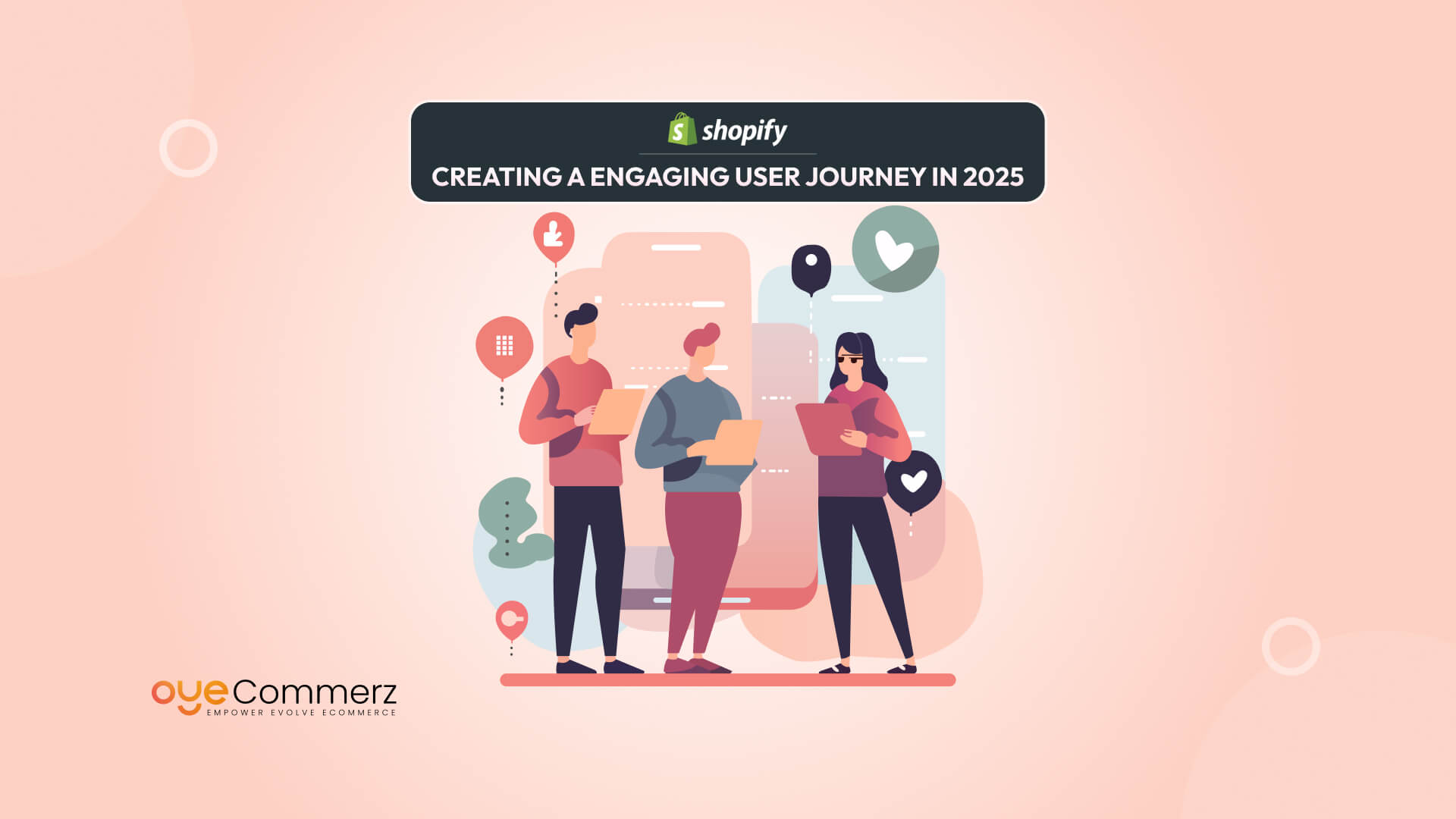In 2024, U.S. eCommerce retail sales reached over $1.14 trillion, and the number is set to grow steadily through 2025, according to Statista. With competition at an all-time high, a Shopify store’s success depends not just on traffic, but on how effectively it guides users through their journey from discovery to purchase.
The user journey on a Shopify store refers to the complete path a visitor takes, from the first interaction to checkout and beyond. An engaging user journey ensures that this path is seamless, intuitive, and personalized, encouraging users to convert, return, and advocate.
In this guide, you’ll learn how to design a high-converting user journey for your Shopify store in 2025, whether you’re optimizing an existing setup or planning a move to Shopify store, backed by technical strategies and real-world application.
Table of Contents
ToggleThe Big Picture: Why User Journey Matters in Shopify Success
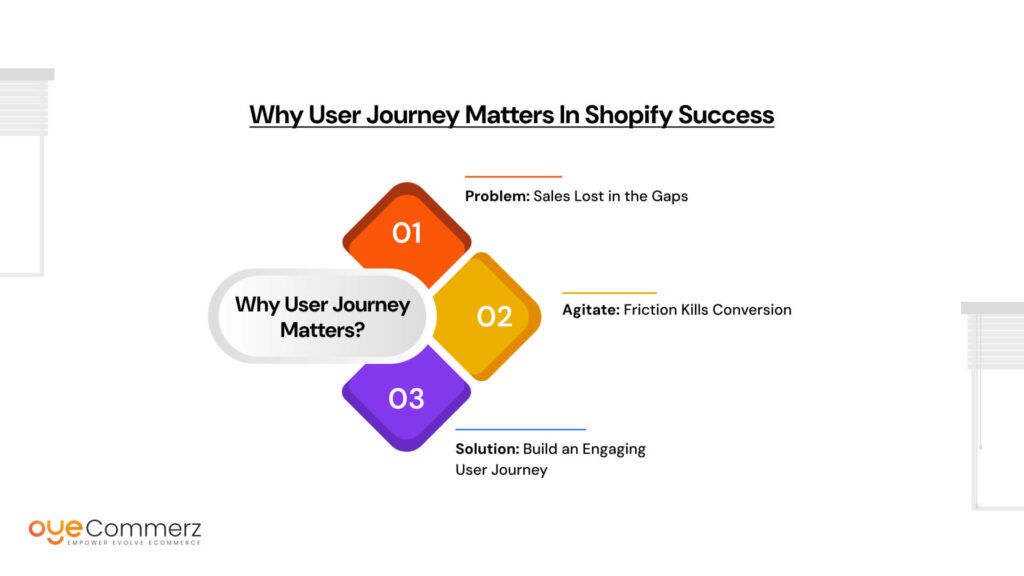
Despite a polished product catalog and visually appealing design, many Shopify stores fail to convert. Why? Because their user journey is fragmented, leading to friction, confusion, and cart abandonment.
Problem: Sales Lost in the Gaps
Customers today expect more than a working website. They want clarity, speed, and relevance. Unfortunately, without a defined user journey on Shopify store, even well-marketed brands lose potential buyers.
Common indicators of a broken journey include:
- Visitors leaving after one page (high bounce rate)
- Users adding products to cart but never checking out
- Repeat traffic with low engagement or interaction
- Abandoned carts with no follow-up
Agitate: Friction Kills Conversion
These breakdowns don’t just affect numbers, they impact trust. Every time a user:
- Gets lost in navigation
- Faces unexpected shipping charges
- Waits too long for page load
- Sees irrelevant product suggestions
…you lose not just a sale, but a customer relationship.
Without optimizing the journey, even aggressive ad spend becomes wasteful, driving traffic into an inefficient process.
Solution: Build an Engaging User Journey
Creating an engaging user journey means constructing a unified experience from homepage to post-purchase. This involves:
- Understanding user intent at each stage
- Reducing the number of clicks from discovery to checkout
- Personalizing navigation, product suggestions, and communication
- Aligning design and content with user behavior
When the journey is optimized, your Shopify store becomes more than a storefront, it becomes a guided path that leads users naturally toward conversion.
This is the foundation of digital success in 2025: frictionless, personalized, and strategically mapped experiences.
Mapping the Ideal Shopify User Journey
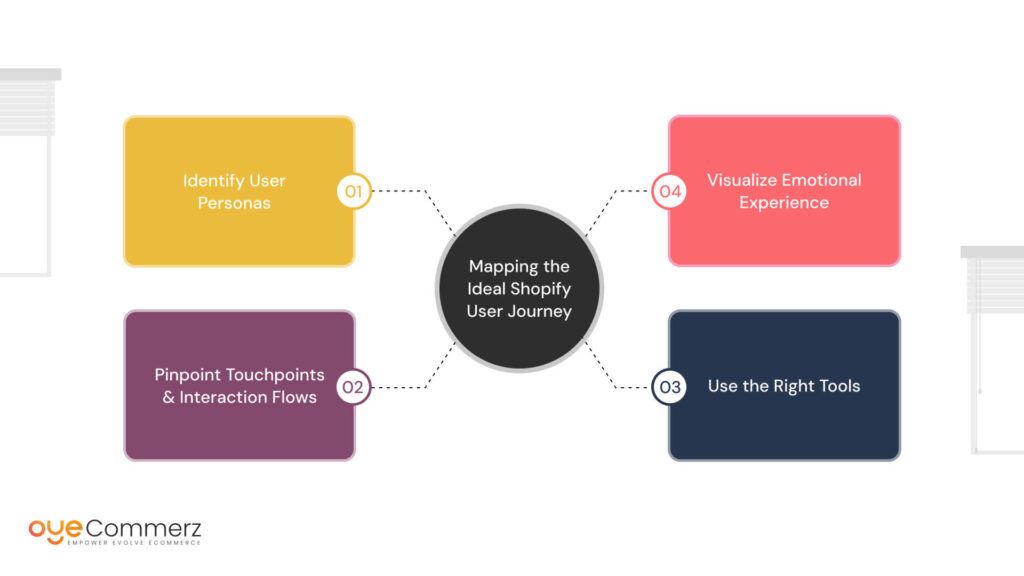
Once you understand what a user journey is, the next step is mapping it precisely. Without a mapped journey, optimization becomes guesswork.
Step 1: Identify User Personas
Start by defining the various audience types visiting your store. Ask:
- Who are they? (e.g., first-time buyers, returning customers, window shoppers)
- What are their goals? (e.g., gifting, comparison, impulse buy)
- What devices are they using? (desktop, mobile, tablet)
- Where are they coming from? (ads, search, email, social)
User personas help predict intent, pain points, and preferred touchpoints, shaping the journey design accordingly.
Step 2: Pinpoint Touchpoints & Interaction Flows
Track the actions users take at each stage:
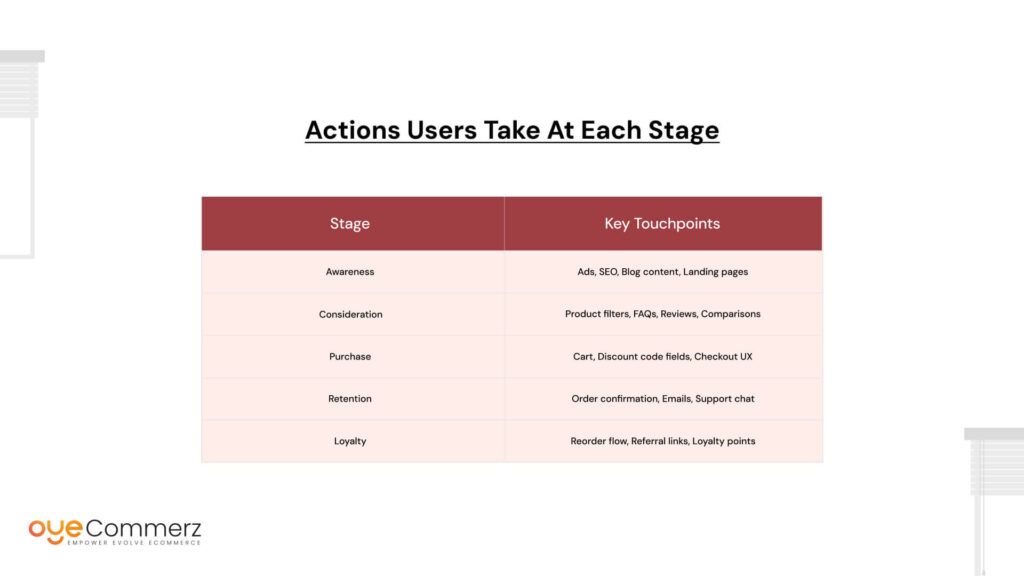
Mapping these flows ensures consistency across every digital interaction.
Step 3: Use the Right Tools
To gather insights and map behavior accurately, leverage tools such as:
- Shopify Analytics – Tracks conversion rates, cart behavior, and funnel drop-offs
- Google Analytics 4 – Identifies traffic sources, session paths, and time on site
- Hotjar – Offers heatmaps and session recordings to visualize real-time user behavior
These tools help identify friction points and user confusion.
Step 4: Visualize Emotional Experience
Beyond just clicks, it’s vital to understand how users feel at each stage:
- Are they confident? Confused? Excited? Frustrated?
- Are CTAs giving clear direction?
- Is the store aligned with user expectations?
Creating an emotionally supportive user journey, through design, speed, tone, and clarity, leads to higher engagement and repeat business.
Mapping the journey isn’t just about charts; it’s about engineering a fluid experience. Every small optimization creates compounding improvements in user retention and revenue.
Common Mistakes That Disrupt the User Journey
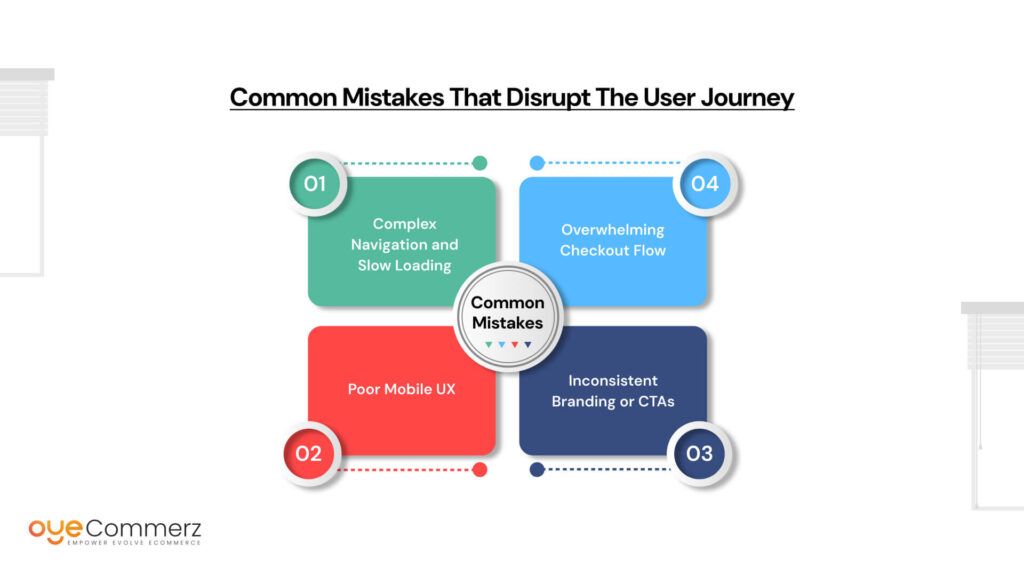
An effective user journey on Shopify store hinges on smooth navigation and engagement. Unfortunately, many stores lose customers by making avoidable mistakes that disrupt the buying process.
Complex Navigation and Slow Loading
If users struggle to find products quickly or if pages load slowly, frustration grows. Complex menus or unclear categories make visitors leave, increasing bounce rates. Slow loading speeds directly reduce conversions, as impatient users abandon carts.
Poor Mobile UX
With over 60% of eCommerce traffic coming from mobile devices, a non-responsive or clunky mobile experience kills engagement. Tiny buttons, unreadable fonts, or difficult checkout on phones push users away.
Inconsistent Branding or CTAs
When branding elements or calls to action vary across pages, users feel confused and less trusting. Mixed messages about offers or unclear button labels create hesitation. Consistency in design and CTA wording builds confidence and drives action.
Overwhelming Checkout Flow
A checkout with too many steps, forced account creation, or unexpected fees causes abandonment. Streamlined, transparent checkout encourages completion. The fewer distractions or confusing inputs, the higher the conversion rate.
Avoiding these common pitfalls is crucial. Each disruption acts as a roadblock, interrupting the engaging user journey your Shopify store needs to thrive in 2025. Careful planning and testing can ensure smooth navigation, consistent messaging, and a frictionless purchase process that turns visitors into customers.
Designing an Engaging User Journey on Shopify Store
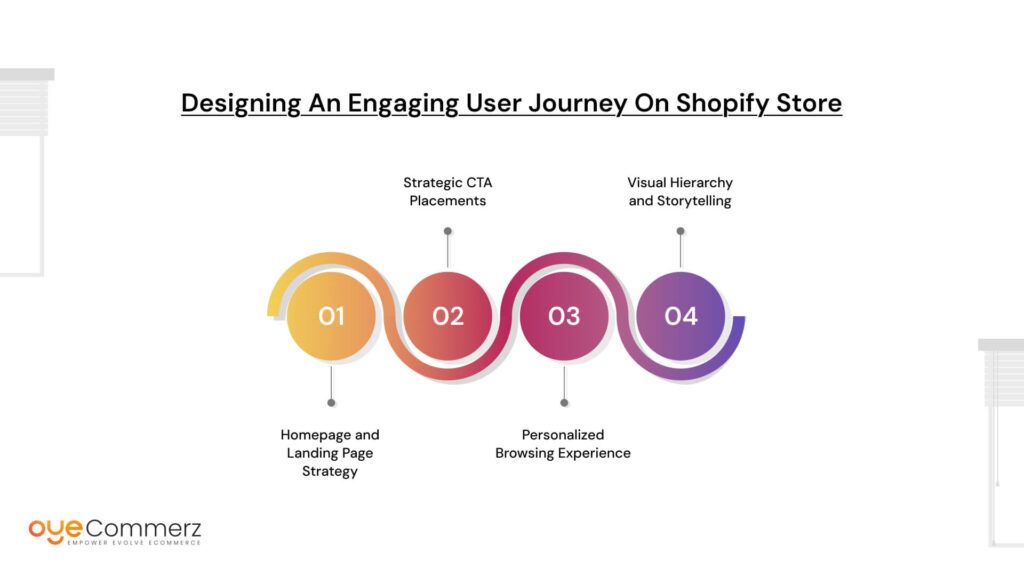
Crafting an engaging user journey on Shopify store starts with intentional design choices that guide users effortlessly toward conversion. Focus on these key areas to build a cohesive and persuasive experience.
Homepage and Landing Page Strategy
Your homepage is the gateway to your store. It should clearly communicate your brand value, highlight popular products, and feature current offers. Use clean layouts with intuitive navigation. For targeted campaigns, design dedicated landing pages aligned with specific promotions or audiences to increase relevance and conversion.
Strategic CTA Placements
Calls to action (CTAs) are the decision points along the user journey. Position them prominently but naturally, on product pages, in banners, and during checkout. Use action-oriented, clear language like “Buy Now,” “Add to Cart,” or “Get 20% Off.” Avoid overwhelming users with too many CTAs, but provide enough guidance to keep them moving forward.
Personalized Browsing Experience
Leverage Shopify’s smart search and product tagging features to tailor the experience. Dynamic search suggestions, personalized product recommendations, and relevant filters help users find exactly what they want. Personalized elements reduce decision fatigue and boost satisfaction, increasing the chance of purchase.
Visual Hierarchy and Storytelling
Effective visual hierarchy directs attention to the most important elements, like product images, benefits, and CTAs. Use consistent fonts, colors, and spacing to make scanning effortless. Combine visuals with storytelling, describe how your product solves problems or improves life, creating an emotional connection that drives action.
By focusing on these elements, you build an engaging user journey that feels seamless and tailored, converting visitors into loyal customers and supporting your Shopify store’s growth in 2025.
Leveraging Personalization and AI in 2025
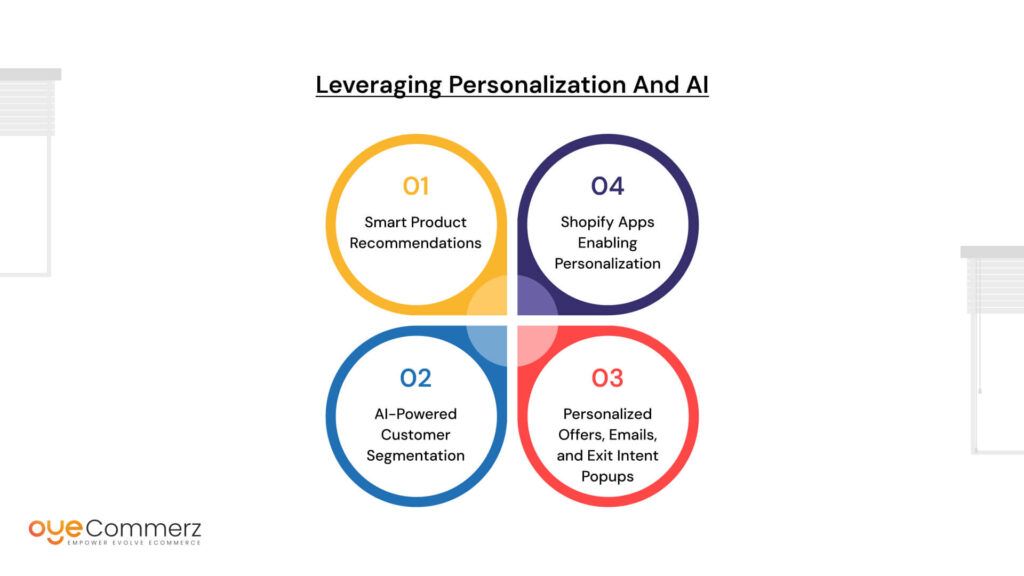
Personalization is no longer optional, it’s essential for creating an engaging user journey on Shopify store in 2025. Modern AI tools allow you to tailor the shopping experience at every touchpoint, increasing conversions and loyalty.
Smart Product Recommendations
AI analyzes browsing and purchase behavior to suggest products users are most likely to buy. These recommendations can appear on homepages, product pages, or cart pages, boosting average order value effortlessly.
AI-Powered Customer Segmentation
Segmenting customers based on behavior, preferences, and demographics enables targeted marketing. AI can automatically group shoppers into meaningful clusters, so you can deliver relevant content and offers without manual effort.
Personalized Offers, Emails, and Exit Intent Popups
Targeted discounts and email campaigns based on user actions improve engagement rates. Exit intent popups offering last-minute deals help recover abandoning visitors, turning potential losses into sales.
Shopify Apps Enabling Personalization
Apps like Klaviyo, LimeSpot, and Privy integrate seamlessly with Shopify to automate personalized marketing. They offer features like dynamic recommendations, segmented email flows, and behavioral popups that enhance the user journey.
Leveraging AI-driven personalization creates a customized experience that meets user expectations and boosts conversion rates. In 2025, these technologies are vital for competitive Shopify stores aiming to deliver an impactful and engaging journey.
Enhancing Product Pages for Better User Experience
Product pages are the heart of your Shopify store’s user journey. A well-optimized product page reduces friction and nudges visitors closer to purchase.
High-Converting Copy and Visuals
Clear, benefit-focused product descriptions answer user questions quickly. Use simple language and highlight key features. Pair copy with high-quality images that showcase multiple angles, colors, or variants.
Video Demos and Customer Reviews
Videos demonstrate product use, building confidence and reducing returns. Customer reviews add social proof, highlight authentic feedback to boost trust. Both videos and reviews increase time spent on page and conversion rates.
Trust Badges, Availability Info, and Delivery Timelines
Display security badges and accepted payment logos near the checkout button. Inform users about stock levels (“Only 3 left!”) and clear delivery timelines (“Ships within 24 hours”) to create urgency and reduce uncertainty.
Improving product pages with focused copy, rich media, and trust signals strengthens the user experience. These enhancements build credibility and help move users smoothly along the Shopify user journey.
Creating a Frictionless Checkout Journey
The checkout process is a critical final step in the user journey on Shopify store. A complicated or slow checkout causes cart abandonment, hurting sales.
Simplified Steps and Guest Checkout
Minimize the number of checkout pages and fields. Allow guest checkout so users don’t feel forced to create accounts, which can deter many shoppers.
Shop Pay and Multiple Payment Options
Shop Pay accelerates checkout with saved information and one-tap purchasing. Offering diverse payment methods, credit cards, PayPal, Apple Pay, caters to user preferences, reducing friction.
Trust Signals and Cart Abandonment Strategies
Show security badges and reassure users about data privacy. Implement cart abandonment solutions like exit offers or reminder emails to recover lost sales. Personalized offers or discounts in abandoned cart emails can prompt users to return and complete purchases.
A frictionless, secure checkout improves conversions and enhances the overall user journey, ensuring that more visitors successfully become customers.
Optimizing Post-Purchase Experience
The user journey on Shopify store doesn’t end at checkout. Post-purchase experience is crucial for retention and building long-term customer relationships.
Confirmation Emails and Tracking Updates
Send immediate order confirmations with clear details. Follow up with tracking information and delivery updates to keep customers informed and reduce anxiety.
Loyalty Programs and Referral Incentives
Reward repeat purchases through points or exclusive discounts. Referral incentives motivate customers to bring in new buyers, amplifying your growth organically.
Review Collection and Community-Building
Prompt buyers to leave reviews with simple follow-up emails. Encourage community engagement on social media or brand forums, fostering loyalty and advocacy.
A seamless post-purchase experience enhances satisfaction and encourages customers to return, completing the full circle of an engaging user journey.
Measuring and Improving the User Journey Continuously
Optimizing the user journey on Shopify store is an ongoing process. Continuous measurement and improvement help identify pain points and boost conversions over time.
Key Performance Indicators (KPIs) to Track
- Bounce Rate: High bounce rates indicate users leave without engaging. Analyze which pages cause exits.
- Conversion Rate: The percentage of visitors who complete purchases reflects journey effectiveness.
- Drop-Off Points: Identify funnel stages where users abandon their path. Pinpointing these helps fix friction.
A/B Testing Key Pages
Run controlled experiments by testing different versions of homepage, product, or checkout pages. Compare layout, CTA wording, or images to see what resonates best. Iterative A/B testing uncovers winning elements that improve engagement.
Customer Feedback Loops
Collect direct feedback via surveys, live chat, or post-purchase forms. User insights reveal issues that data alone might miss. Addressing concerns raised by real shoppers refines the journey and builds trust.
Regularly reviewing data and user input enables data-driven decisions. Combining quantitative KPIs with qualitative feedback ensures the user journey on Shopify store remains smooth, relevant, and optimized for maximum conversions.
Future of User Journey on Shopify Store in 2025 & Beyond
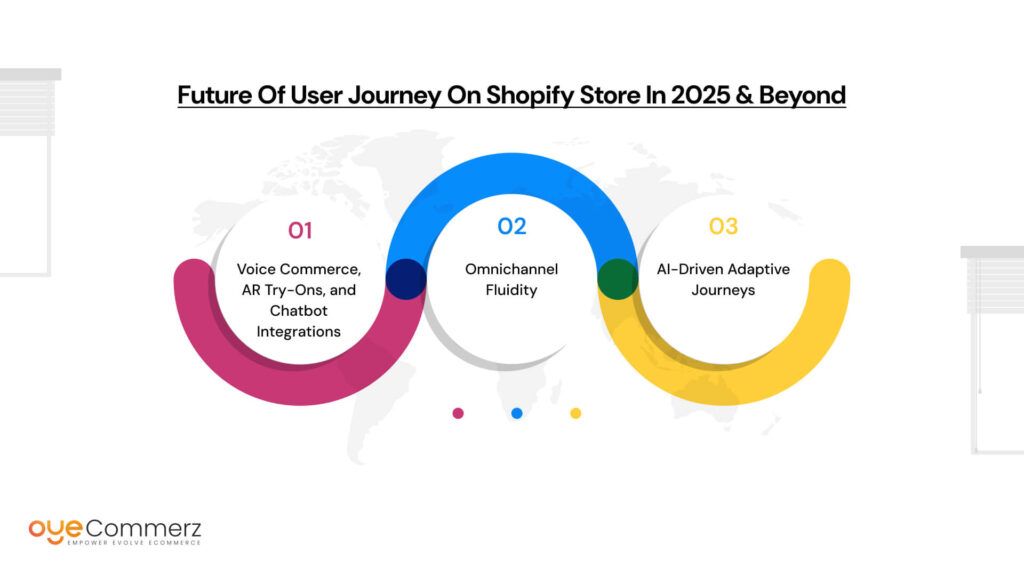
The future of the user journey on Shopify store is driven by emerging technologies that create more immersive, seamless experiences.
Voice Commerce, AR Try-Ons, and Chatbot Integrations
Voice-enabled shopping will simplify product searches. Augmented reality (AR) try-ons allow customers to virtually test products, especially in fashion and home decor. Chatbots provide instant support, enhancing engagement and guiding users in real-time.
Omnichannel Fluidity
Shoppers expect consistent experiences across mobile apps, websites, physical stores, and social platforms. Shopify stores will integrate channels for a frictionless journey, enabling users to switch platforms without disruption.
AI-Driven Adaptive Journeys
Artificial intelligence will dynamically adapt the user journey based on real-time behavior, personalizing content, offers, and navigation. This adaptive approach anticipates needs and proactively improves satisfaction.
Staying ahead with these innovations ensures Shopify merchants can deliver highly engaging user journeys that meet evolving consumer expectations in 2025 and beyond.
Ready to elevate your Shopify store with a truly engaging user journey?
At OyeCommerz, we specialize in tailored Shopify services that create seamless, engaging user journeys designed to boost your sales and grow your brand.
Whether you’re launching a new store or optimizing an existing one, our expert team is here to help you succeed.
Don’t wait, partner with OyeCommerz today and transform your Shopify store into a conversion powerhouse!
Contact to Migrate your Site to Shopify Now
Conclusion
Optimizing the user journey on Shopify stores is crucial for success. A seamless and engaging user journey not only attracts visitors but also converts them into loyal customers. Every interaction, from discovery to post-purchase, should be thoughtfully designed to reduce friction and enhance satisfaction.
By mapping and continuously optimizing your user journey, you create a smooth path that drives sales and builds lasting relationships. Don’t let missed opportunities hold your store back.
Start focusing on your user journey on Shopify store today and watch your conversions and customer loyalty soar. Take action now to craft an engaging journey that sets your Shopify store apart in 2025 and beyond.
Frequently Asked Questions
Optimize your site speed, use smart CTAs, enable personalized experiences, and engage customers with live chat and email marketing.
Use Shopify Analytics, Google Analytics, or apps like Hotjar to track user behavior, touchpoints, and conversion paths.
Identify your user personas, outline each stage (awareness to loyalty), define touchpoints, and map emotions and actions at every step.
Leverage SEO, run targeted ads, offer limited-time deals, engage on social media, and create valuable content.
Search engine optimization (SEO)
Social media marketing
Influencer partnerships
Email campaigns with offers

